On-Chip Miniaturized Bandpass Filter Using GaAs-Based Integrated Passive Device Technology For L-Band Application
Abstract
:1. Introduction
2. Materials and Methods
2.1. Design and Circuit Analysis
2.1.1. Model Inside the Segment Box
2.1.2. Models Outside the Segment Box
2.1.3. Embedded Capacitor
2.1.4. Parasitic Effects Associated with the Substrate
2.2. IPD Fabrication Process
3. Discussion and Results
3.1. Effects of Variable Dimension Parameters
3.2. Results
4. Conclusions
Author Contributions
Funding
Conflicts of Interest
References
- Liang, J.G.; Wang, C.; Kim, N.Y. Implementation of ultra-wideband bandpass filter with modularized design based on synchronous-quasi resonance and double-curved-route. IET Microw. Antennas Propag. 2018, 12, 1175–1184. [Google Scholar] [CrossRef]
- Lu, D.; Tang, X.H.; Barker, N.S.; Li, M.; Yan, T.F. Synthesis-applied highly selective tunable dual-mode BPF with element-variable coupling matrix. IEEE Trans. Microw. Theory Tech. 2018, 66, 1804–1816. [Google Scholar] [CrossRef]
- Wang, Z.J.; Wang, C.; Kim, N.Y. Dual-/triple-wideband microstrip bandpass filter using independent triple-mode stub-loaded resonator. Microw. Opt. Technol. Lett. 2017, 60, 56–64. [Google Scholar] [CrossRef]
- Qiang, T.; Wang, C.; Kim, N.Y. Quad-wideband bandpass filter with high design flexibility based on independent triple-mode resonators. Microw. Opt. Technol. Lett. 2017, 59, 1655–1661. [Google Scholar] [CrossRef]
- Liu, H.W.; Ren, B.P.; Hu, S.X.; Guan, X.H.; Wen, P.; Tang, J.M. High-order dual-band superconducting bandpass filter with controllable bandwidths and multitransmission zeros. IEEE Trans. Microw. Theory Tech. 2017, 65, 3813–3823. [Google Scholar] [CrossRef]
- Tsukamoto, O.; Ogawa, J. Perspectives of elementary technologies for AC power applications of high temperature superconductors. J. Mater. Process. Technol. 2007, 181, 6–11. [Google Scholar] [CrossRef]
- Yang, T.; Tamura, M.; Itoh, T. Super compact low-temperature co-fired ceramic bandpass filters using the hybrid resonator. IEEE Trans. Microw. Theory Tech. 2010, 58, 2896–2907. [Google Scholar] [CrossRef]
- Dai, X.; Zhang, X.Y.; Kao, H.L.; Wei, B.H.; Xu, J.X.; Li, X. LTCC bandpass filter with wide stopband based on electric and magnetic coupling cancellation. IEEE Trans. Compon. Packag. Manuf. Technol. 2014, 4, 1705–1713. [Google Scholar]
- Zhu, Y.Y.; Yang, Y.J.; Chen, J.X. High-performance bandpass filter using HTCC stepped-impedance resonators. IET Microw. Antennas Propag. 2018, 12, 56–62. [Google Scholar] [CrossRef]
- Lei, D.; Wang, T.; Cao, D.; Fei, J. Adaptive dynamic surface control of mems gyroscope sensor using fuzzy compensator. IEEE Access 2016, 4, 4148–4154. [Google Scholar] [CrossRef]
- Chang, S.C.; Chen, Y.M.; Chang, S.F.; Jeng, Y.H.; Wei, C.L.; Huang, C.H.; Jeng, C.P. Compact millimeter-wave CMOS bandpass filters using grounded pedestal stepped-impedance technique. IEEE Trans. Microw. Theory Tech. 2010, 58, 3850–3859. [Google Scholar] [CrossRef]
- Hsu, C.Y.; Chen, C.Y.; Chuang, H.R. A 60-GHz millimeter-wave bandpass filter using 0.18-μm CMOS technology. IEEE Electron Device Lett. 2008, 29, 246–248. [Google Scholar]
- Talwalkar, N.A.; Yue, C.P.; Wong, S.S. Analysis and synthesis of on-chip spiral inductors. IEEE Trans. Electron. Devices 2005, 52, 176–182. [Google Scholar] [CrossRef]
- Wang, C.; Lee, W.S.; Zhang, F.; Kim, N.Y. A novel method for the fabrication of integrated passive devices on SI-GaAs substrate. Int. J. Adv. Manuf. Technol. 2011, 52, 1011–1018. [Google Scholar] [CrossRef]
- Wang, C.; Kim, N.Y. High performance WLAN balun using integrated passive technology on SI-GaAs substrate. Microw. Opt. Technol. Lett. 2012, 54, 1301–1305. [Google Scholar] [CrossRef]
- Kim, E.S.; Kim, N.Y. Micro-Fabricated Resonator Based on Inscribing a Meandered-Line Coupling Capacitor in an Air-Bridged Circular Spiral Inductor. Micromachines 2018, 9, 294. [Google Scholar] [CrossRef]
- Chen, J.; Liou, J.J. Improved and physical-based model for symmetrical spiral inductors. IEEE Trans. Electron. Devices 2006, 53, 1300–1309. [Google Scholar] [CrossRef]
- Bahl, I.J. Lumped Elements for RF and Microwave Circuit, 1st ed.; Artech House: London, UK, 2003; pp. 17–36. [Google Scholar]
- Chen, J. On-Chip Spiral Inductor Transformer Design and Modeling for RF Applications. Ph.D. Dissertation, University of Central Florida, Orlando, FL, USA, 2006. [Google Scholar]
- Matthaei, G.L.; Chinn, G.C.; Plott, C.H.; Dagli, N. A simplified means for computation for interconnect distributed capacitances and inductances. IEEE Trans. Comput.-Aided Des. Integr. Circuits Syst. 1992, 11, 513–524. [Google Scholar] [CrossRef]
- Cao, Y.; Groves, R.A.; Zamdmer, N.D.; Plouchart, J.O.; Wachnik, R.A.; Huang, X.J.; King, T.J.; Hu, C.M. Frequency-independent equivalent-circuit model for on-chip spiral inductors. IEEE J. Solid-State Circuits 2003, 38, 419–426. [Google Scholar] [CrossRef]
- Yuan, J.S.; Eisenstadt, W.R.; Liou, J.J. A novel lossy and dispersive interconnect model for integrated circuit simulation. IEEE Trans. Comp. Hybrids Manuf. Technol. 1990, 13, 275–280. [Google Scholar] [CrossRef]
- Nirmalathas, A.; Lim, C.; Novak, D.; Castleford, D.; Waterhouse, R.; Smith, G. Millimeter-wave fiber-wireless access systems incorporating wavelength division multiplexing. In Proceedings of the 2000 Asia-Pacific Microwave Conference, Sydney, Australia, 3–6 December 2000. [Google Scholar]
- Lim, K.; Pinel, S.; Davis, M.F.; Sutono, A.; Lee, C.H.; Heo, D.; Obatoynbo, A.; Laskar, J.; Tentzeris, E.M.; Tummala, R. RF-system-on-package (SOP) for wireless communications. IEEE Microw. Mag. 2002, 3, 88–99. [Google Scholar]
- Li, Y.; Wang, C.; Kim, N.Y. A high performance compact Wilkinson power divider using GaAs-based optimized integrated passive device fabrication process for LTE application. Solid-State Electron. 2015, 103, 147–153. [Google Scholar] [CrossRef]
- Wang, C.; Jeon, H.; Kim, N.Y. A compact spiral-coupled directional coupler for a mobile RFID reader via integrated passive technology. Microw. Opt. Technol. Lett. 2015, 57, 2142–2146. [Google Scholar] [CrossRef]
- Kumar, A.; Meng, F.Y.; Wang, C.; Adhikari, K.K.; Qiang, T.; Wu, Q.; Wu, Y.L. Design Analysis of Integrated Passive Device-Based Balun Devices with High Selectivity for Mobile Application. IEEE Access 2019, 7, 23169–23176. [Google Scholar] [CrossRef]
- Wang, Z.J.; Kim, E.S.; Liang, J.G.; Kim, N.Y. QFN-Packaged Bandpass Filter With Intertwined Circular Spiral Inductor and Integrated Center-Located Capacitors Using Integrated Passive Device Technology. IEEE Access 2019, 7, 13597–13607. [Google Scholar] [CrossRef]
- Quan, C.H.; Wang, Z.J.; Lee, J.C.; Kim, E.S.; Kim, N.Y. A Highly Selective and Compact Bandpass Filter with a Circular Spiral Inductor and an Embedded Capacitor Structure Using an Integrated Passive Device Technology on a GaAs Substrate. Electronics 2019, 8, 73. [Google Scholar] [CrossRef]
- Ahmadivand, A.; Gerislioglu, B.; Ramezani, Z. Gated graphene island-enabled tunable charge transfer plasmon terahertz metamodulator. Nanoscale 2019, 11, 8091–8095. [Google Scholar] [CrossRef]
- Hong, J.S. Microstrip Filters for RF/Microwave Applications, 2nd ed.; John Wiley & Sons: Hoboken, NJ, USA, 2011; pp. 203–263. ISBN 978-0-470-40877-3. [Google Scholar]
- Nooshnab, V.; Ahmadivand, A. Optothermally Functional Charge Transfer Plasmon Modulator. IEEE Photon. Technol. Lett. 2017, 29, 1556–1559. [Google Scholar] [CrossRef]
- Kruger, B.A.; Joushaghani, A.; Poon, J.K.S. Design of electrically driven hybrid vanadium dioxide (VO2) plasmonic switches. Opt. Express 2012, 20, 23598–23609. [Google Scholar] [CrossRef]
- Lu, D.; Barker, N.S.; Tang, X.H. Miniaturized two-pole lumped BPF with four controllable TZs using multiple coupling paths. IEEE Microw. Wirel. Compon. Lett. 2017, 27, 563–565. [Google Scholar] [CrossRef]
- Liu, H.W.; Ren, B.P.; Liu, F.; Guan, X.H.; Wen, P.; Ma, Z.W. Dual-Band High-Temperature Superconducting Bandpass Filter Using Dual-Mode Hairpin Ring Resonator. IEEE Trans. Appl. Supercond. 2016, 26, 1501704. [Google Scholar] [CrossRef]
- Zhang, X.Y.; Dai, X.; Kao, H.L.; Wei, B.H.; Cai, Z.Y.; Xue, Q. Compact LTCC Bandpass Filter With Wide Stopband Using Discriminating Coupling. IEEE Trans. Microw. Theory Technol. 2014, 4, 656–663. [Google Scholar] [CrossRef]
- Wong, K.W.; Mansour, R.R.; Weale, G. Reconfigurable bandstop and bandpass filters with wideband balun using IPD technology for frequency agile applications. IEEE Trans. Compon. Hybrids. Manuf. Technol. 2017, 7, 610–620. [Google Scholar] [CrossRef]
- Liang, J.G.; Wang, C.; Kim, N.Y. Integrated passive device fabricated and chip-on-board packaged filter employing mixed electric–magnetic coupling scheme. IET Microw. Antennas Propag. 2018, 12, 2191–2198. [Google Scholar] [CrossRef]
- Luo, X.H.; Cheng, X.; Zhang, L.; Chen, F.J.; Xia, X.L.; Han, J.A.; Deng, X.J. A Miniaturized On-Chip BPF With Ultrawide Stopband Based on Lumped Pi-Section and Source-Load Coupling. IEEE Microw. Wirel. Compon. Lett. 2019, 29, 516–519. [Google Scholar] [CrossRef]
- Zhang, Z.Q.; Liao, X.P. Micromachined Passive Bandpass Filters Based on GaAs Monolithic-Microwave-Integrated-Circuit Technology. IEEE Trans. Electron Devices 2013, 60, 221–228. [Google Scholar] [CrossRef]
- Xiao, Y.; Shan, P.Z.; Zhao, Y.; Sun, H.J.; Yang, F. Design of a W-Band GaAs-Based SIW Chip Filter Using Higher Order Mode Resonances. IEEE Microw. Wirel. Compon. Lett. 2019, 29, 104–106. [Google Scholar] [CrossRef]
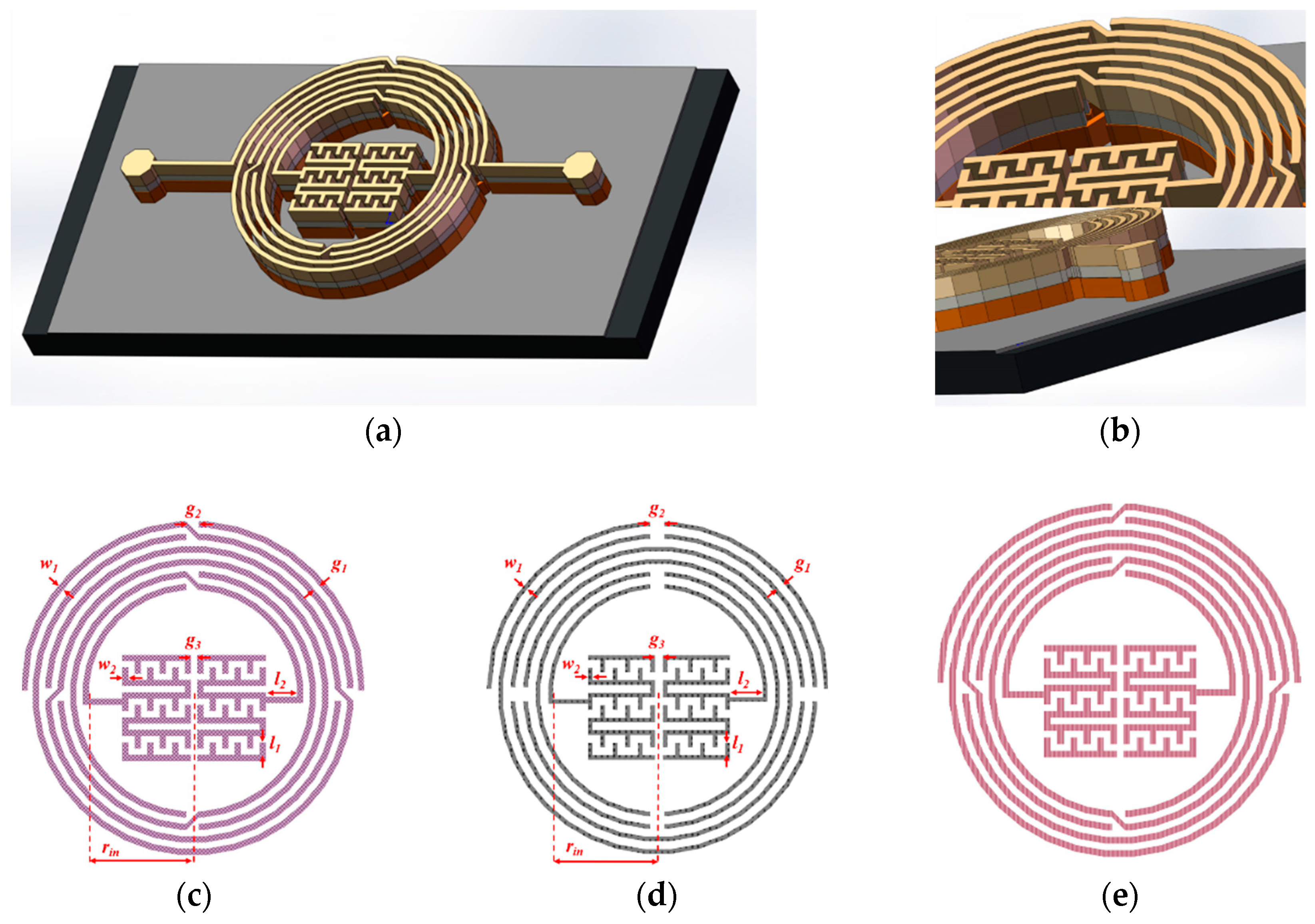

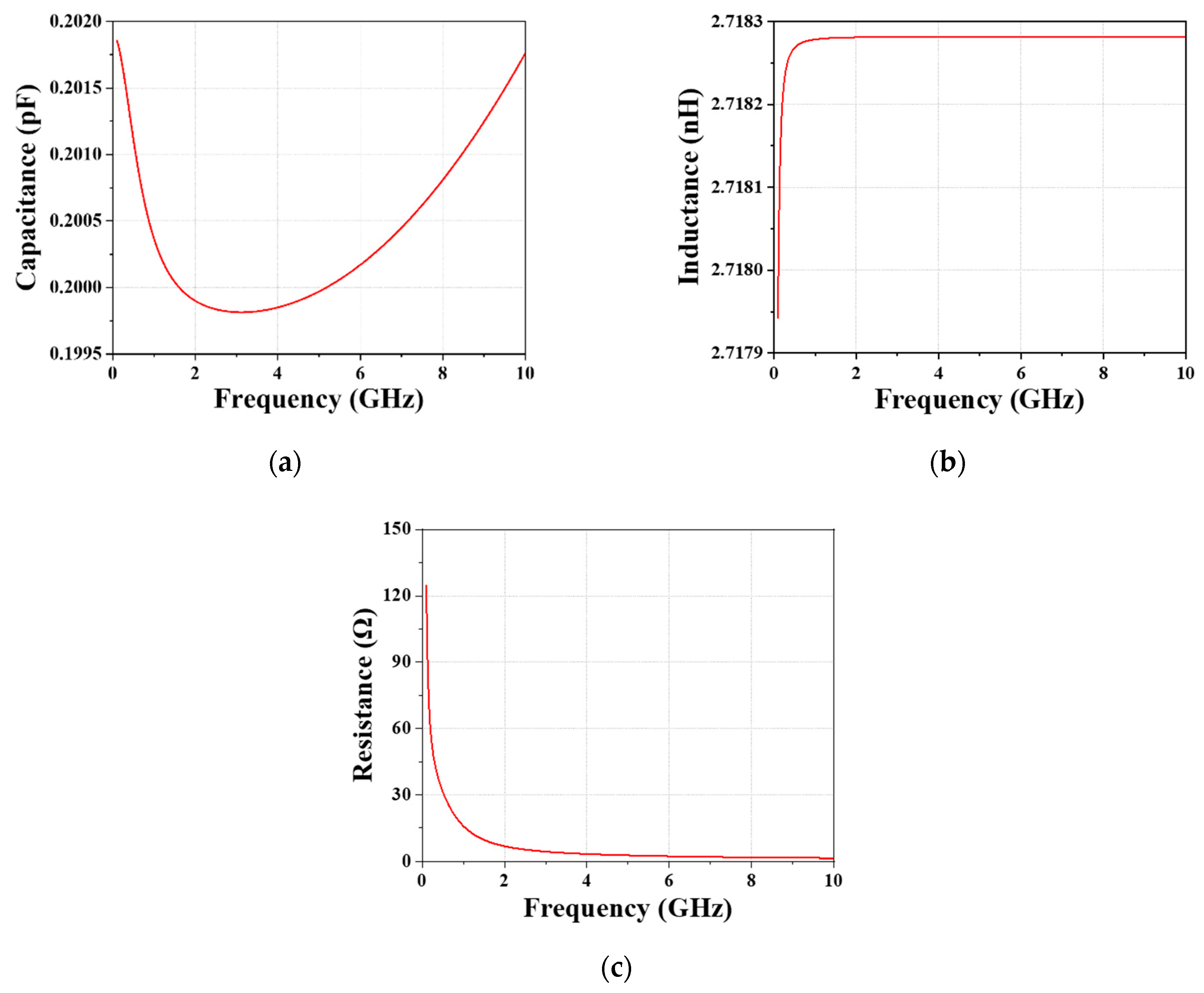
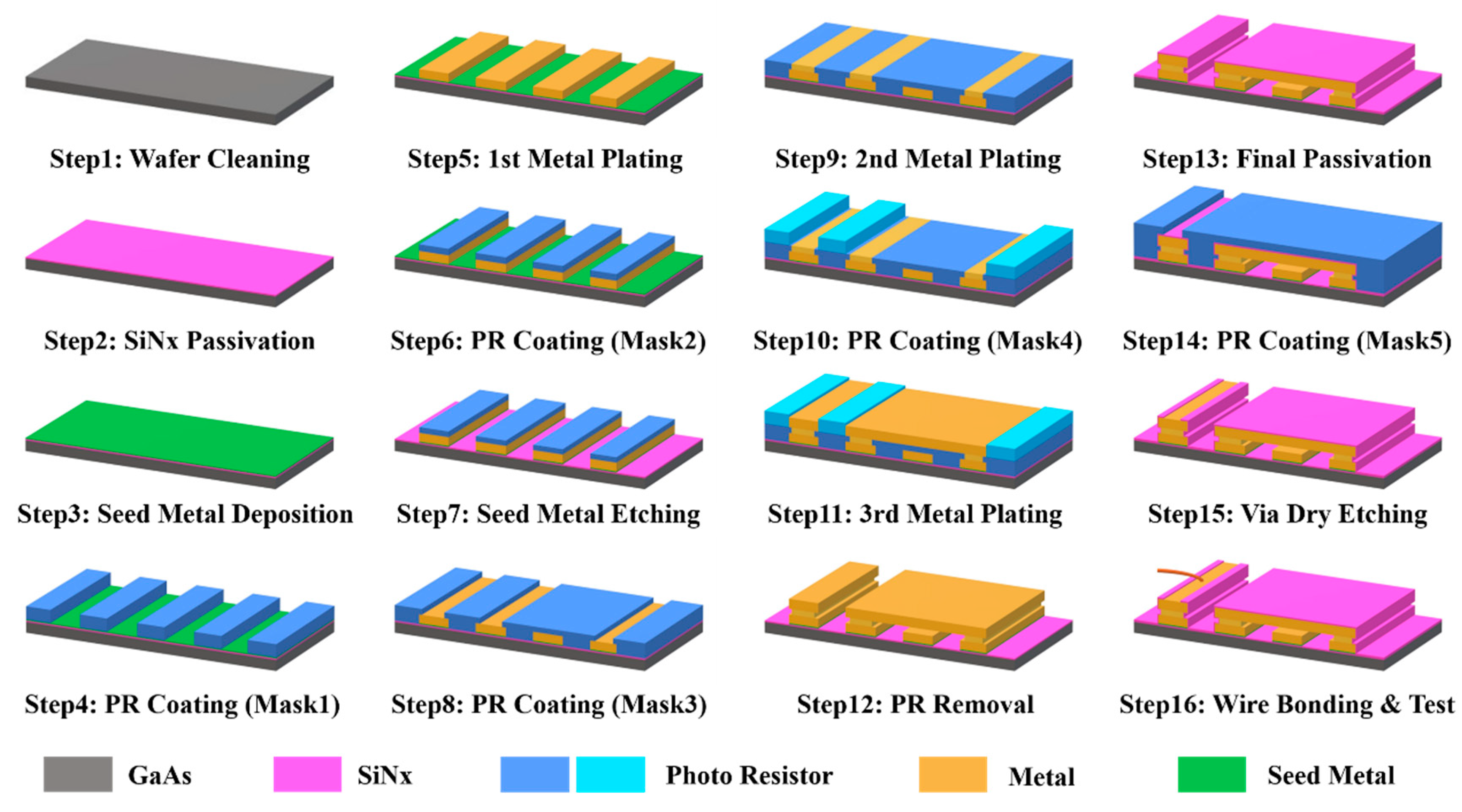
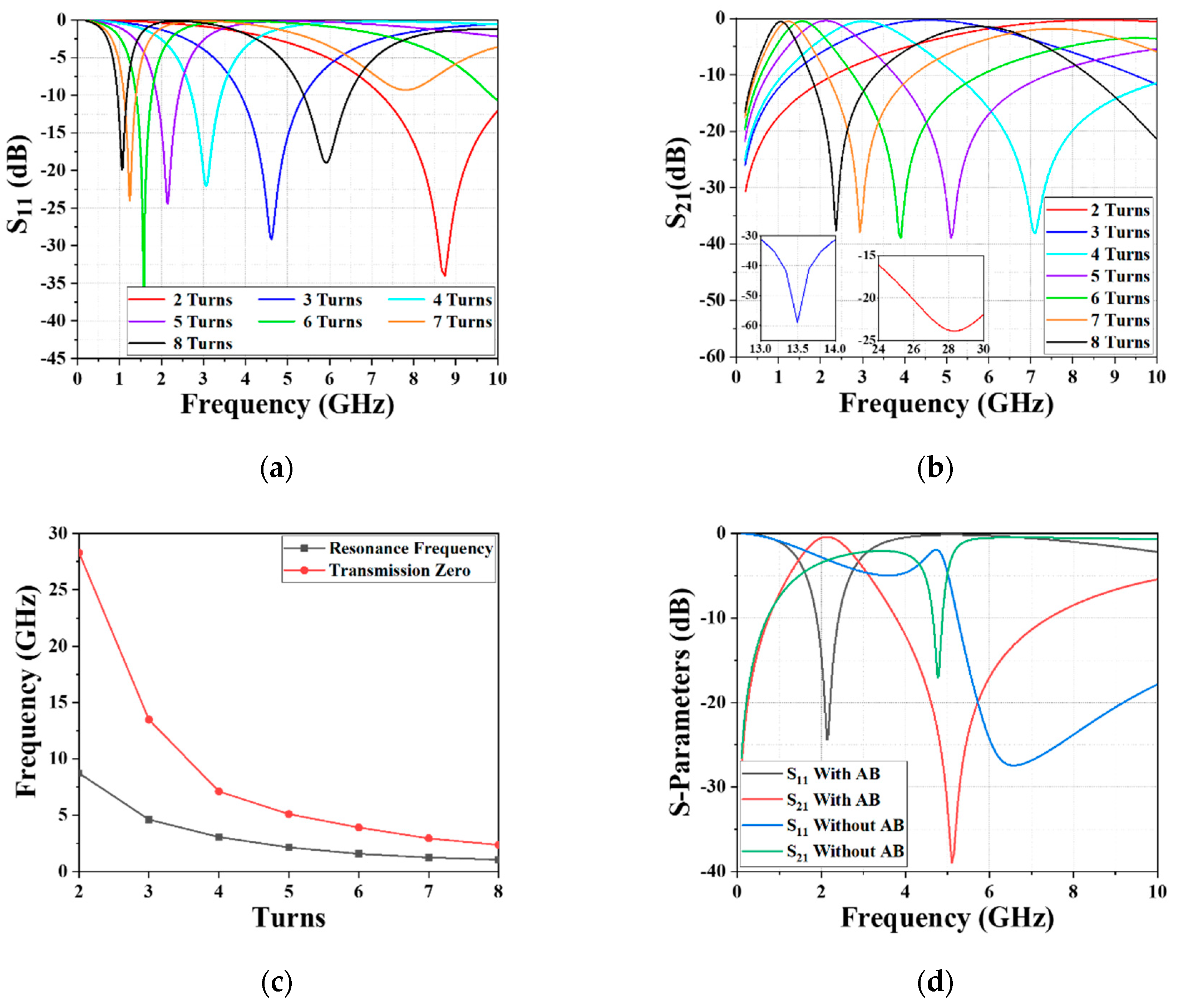
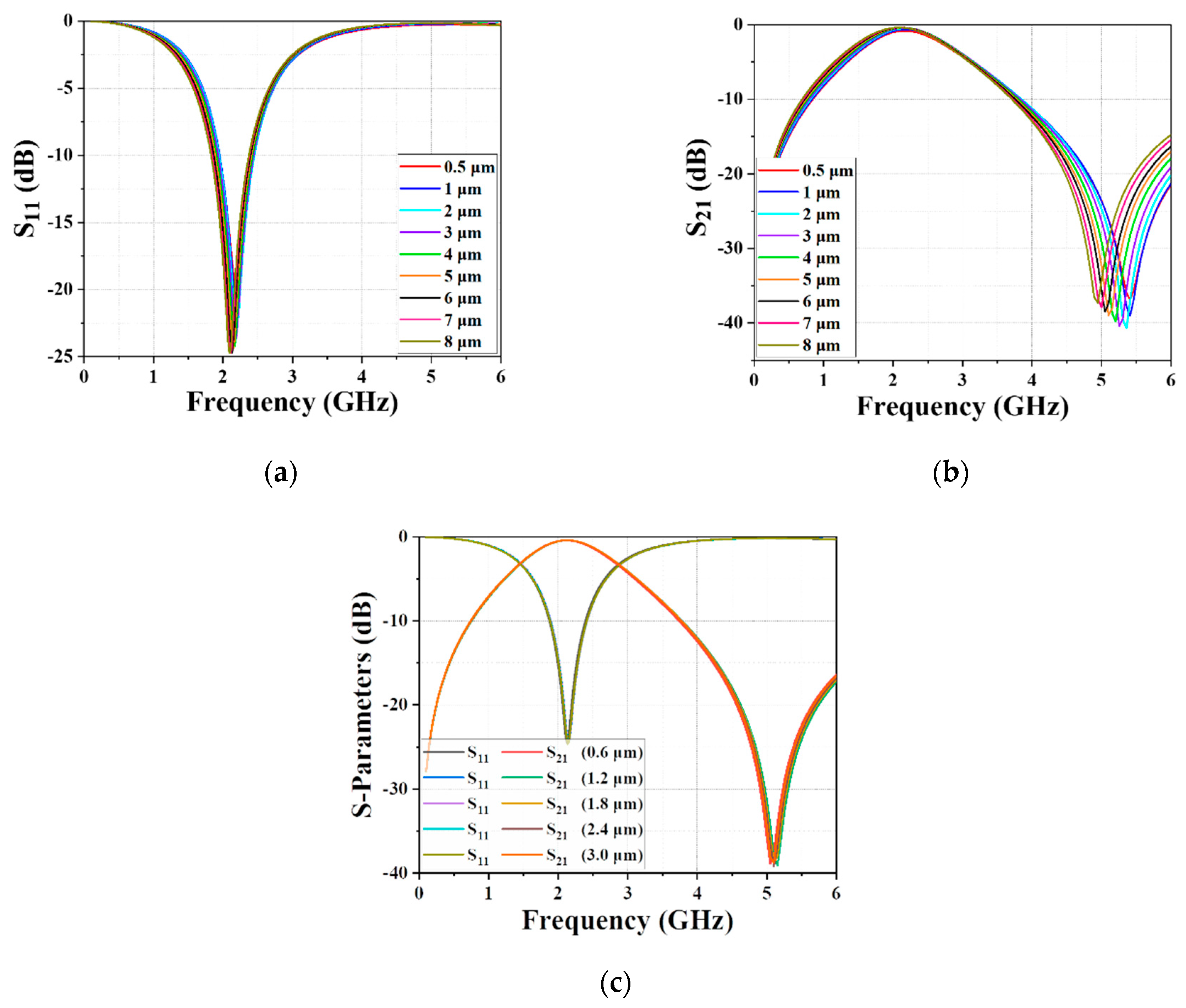
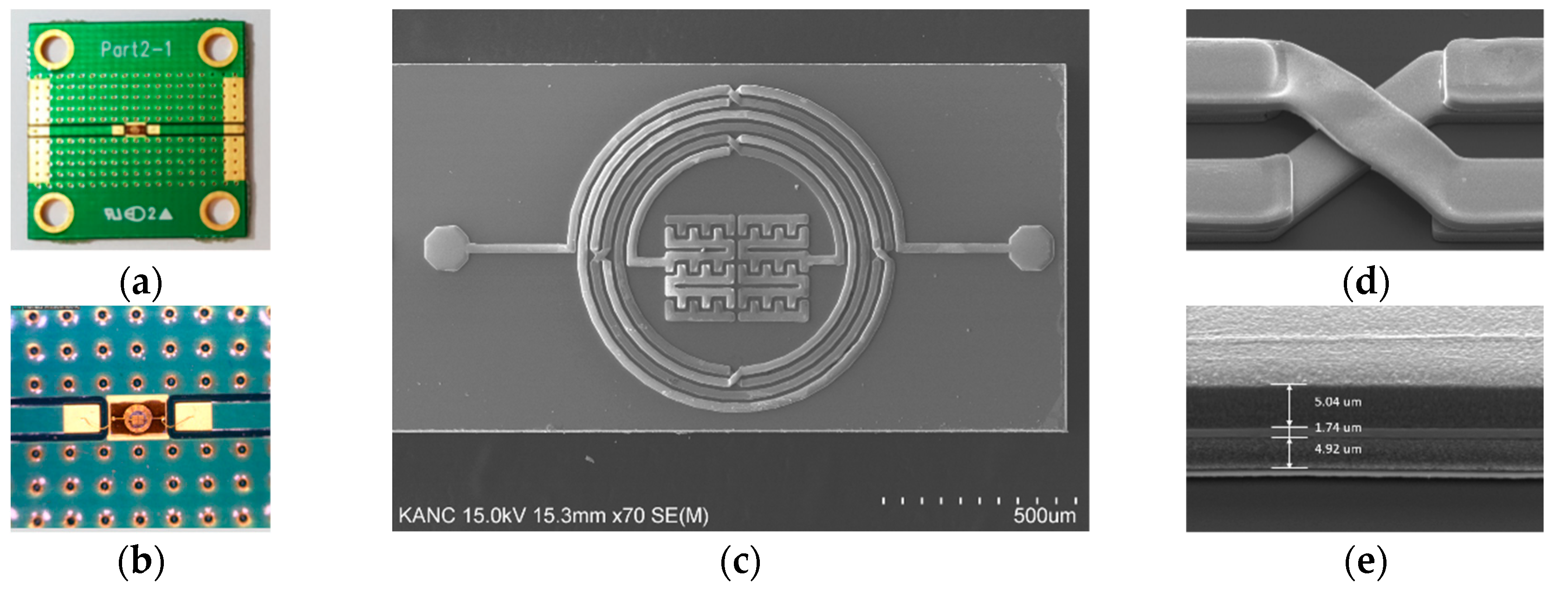

| Parameter (mm) | w1 | w2 | g1 | g2 | g3 | rin | l1 | l2 | Thickness |
|---|---|---|---|---|---|---|---|---|---|
| Leads and Bond | 15 | 15 | 15 | 30 | 15 | 250 | 75 | 30 | 5 |
| Text | 11 | 11 | 19 | 34 | 19 | 252 | 79 | 30 | 1.8 |
| Fabrication Objective | Technique | Material | Application of Step |
|---|---|---|---|
| Passivation layer | PECVD | SiNx | 2, 13 |
| Photoresistor | Spin-coating | Negative/positive PR | 4, 6, 8, 10, 14 |
| PR removal | Lift-off | Acetone | 5, 12 |
| Seed metal | Sputtering | Ti/Au | 3 |
| Metal layer | Electroplating | Cu/Au | 5, 9, 10 |
| Via | ICP etching | SF6/O6 | 7, 15 |
| Ref. | Technique | CF (GHz) | IL (dB) | RL (dB) | FBW (%) | Circuit Area |
|---|---|---|---|---|---|---|
| [34] | Microstrip | 0.975 | 1.1 | >20 | 13.3 | 0.094λ0 × 0.08λ0 |
| [35] | HTS | 1.9/2.6 | 0.18/0.32 | >16 | 2.6/2.4 | 0.182λ0 × 0.156λ0 |
| [36] | LTCC | 2.4 | 2.4 | 15 | 12.5 | 0.058λ0 × 0.058λ0 |
| [9] | HTCC | 2.25 | 1.8 | >15 | 5.5 | 6.9 × 39.9 mm2 |
| [37] | Si-based IPD | 1.7 | 2.54 | 12 | 16 | 2.6 × 1.5 mm2 |
| This work | GaAs-based IPD | 2 | 0.38 | 40 | 72.53 | 0.037λ0 × 0.019λ0 (1.54 × 0.8 mm2) |
| Ref. | Technique | CF (GHz) | IL (dB) | RL (dB) | FBW (%) | Circuit Area |
|---|---|---|---|---|---|---|
| [38] | IPD | 3.2/5.8 | 1.2/0.6 | 22/25 | 7.8/33.3 | 0.2λ0 × 0.11λ0 |
| [39] | HBT | 3.35 | 2.05 | 19 | 55 | 0.02λ0 × 0.05λ0 |
| [40] | MMIC | 3.01 | 5.6 | 7.5 | - | 0.7 × 0.4 mm2 |
| [41] | SIW | 93 | 4.3 | >13.5 | 3.4 | 2.31λ0 × 1.57λ0 |
| This work | IPD | 2 | 0.38 | 40 | 72.53 | 0.037λ0 × 0.019λ0 (1.54 × 0.8 mm2) |
© 2019 by the authors. Licensee MDPI, Basel, Switzerland. This article is an open access article distributed under the terms and conditions of the Creative Commons Attribution (CC BY) license (http://creativecommons.org/licenses/by/4.0/).
Share and Cite
Zhu, B.-H.; Kim, N.-Y.; Wang, Z.-J.; Kim, E.-S. On-Chip Miniaturized Bandpass Filter Using GaAs-Based Integrated Passive Device Technology For L-Band Application. Materials 2019, 12, 3045. https://doi.org/10.3390/ma12183045
Zhu B-H, Kim N-Y, Wang Z-J, Kim E-S. On-Chip Miniaturized Bandpass Filter Using GaAs-Based Integrated Passive Device Technology For L-Band Application. Materials. 2019; 12(18):3045. https://doi.org/10.3390/ma12183045
Chicago/Turabian StyleZhu, Bao-Hua, Nam-Young Kim, Zhi-Ji Wang, and Eun-Seong Kim. 2019. "On-Chip Miniaturized Bandpass Filter Using GaAs-Based Integrated Passive Device Technology For L-Band Application" Materials 12, no. 18: 3045. https://doi.org/10.3390/ma12183045
APA StyleZhu, B.-H., Kim, N.-Y., Wang, Z.-J., & Kim, E.-S. (2019). On-Chip Miniaturized Bandpass Filter Using GaAs-Based Integrated Passive Device Technology For L-Band Application. Materials, 12(18), 3045. https://doi.org/10.3390/ma12183045






